 |
 |
|
|||||||||||
 |
 |
||||||||||||
|
|
|
|
|
|
|
||||||||
 |
|
|
|
|
|
 |
|||||||
|
|
|
|
|||||||||||
|
|
|||||||||||||
|
|
|
|
|
|
|
|
|
|
|
|
|
|
|
Results 311 to 320 of 679
-
07-18-2016, 06:24 AM #311I gather darkness to please me...
-
07-18-2016, 11:24 AM #312Super telescope finds hundreds of previously undetectable galaxies
By James Griffiths, CNN | Updated 3:25 AM ET, Sun July 17, 2016
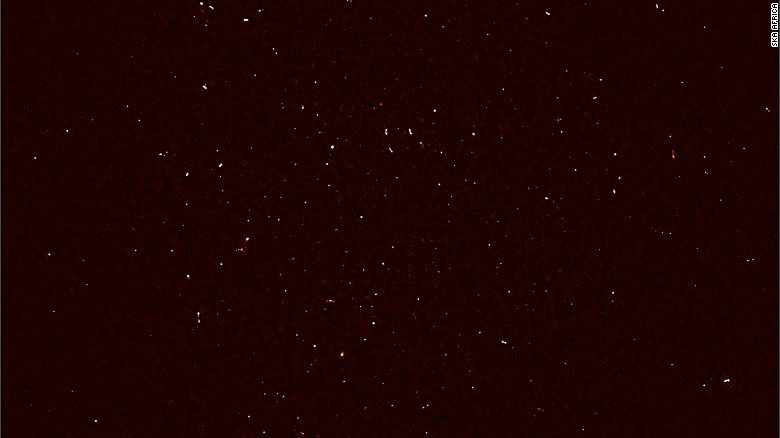
First image released by the MeerKAT radio telescope showing hundreds of previously undetected galaxies.
(CNN) - A South African radio telescope has revealed hundreds of galaxies in a tiny corner of the universe where only 70 had been seen before.
The images, taken by MeerKAT telescope, are an indication of the detail the southern hemisphere's most powerful radio telescope may be able to provide when it is fully operational later this year.
At present, 16 of MeerKAT's 64 dishes are scanning the skies. As well as its scientific goals, the project serves as a technological demonstration of South Africa's capability to host the Square Kilometer Array, a huge multiradio-telescope project to be built in Australia and South Africa comprising dozens of dishes.
"Based on the results being shown today, we are confident that after all 64 dishes are in place, MeerKAT will be the world's leading telescope of its kind until the advent of SKA," Professor Justin Jonas, SKA South Africa chief technologist, said in a statement.
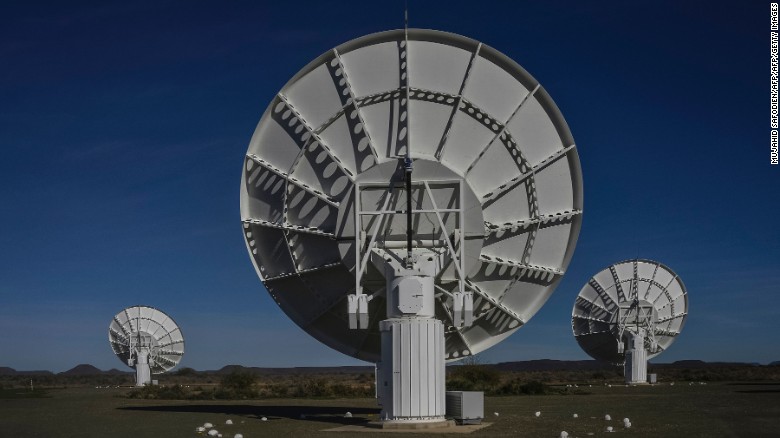
Dishes forming part of the giant MeerKAT radio telescope array.
Square Kilometer Array
The SKA, intended to be operational by the 2020s, will consist of around 3,000 dishes spread across a one square kilometer (0.4 square mile) area and will allow astronomers to peer deeper into space than ever before.
SKA says it will have a discovery potential 10,000 times that of the most advanced modern instruments and will explore black holes, supernovae, dark energy and look into the origins of the universe.
More than 20 countries are members of SKA, with Australia and South Africa being the main bases of operation. The project is headquartered in the UK.
'Exceptionally beautiful images'
MeerKAT's images, taken of a patch of sky covering less than 0.01% of the total, reveal more than 1,300 galaxies in the distant universe, where only around 70 had been previously detected.
They include a galaxy around 200 million light years away where new stars are being formed from hydrogen gas in large numbers, and a massive black hole spewing out jets of powerful electrons moving at close to the speed of light.
In this image taken by the MeerKAT radio telescope, we see a galaxy approximately
200 million light years away where hydrogen gas is being used up to form stars in large numbers.
"Today's exceptionally beautiful images ... demonstrate that MeerKAT has joined the big leagues of world radio astronomy," said Fernando Camilo, SKA South Africa chief scientist.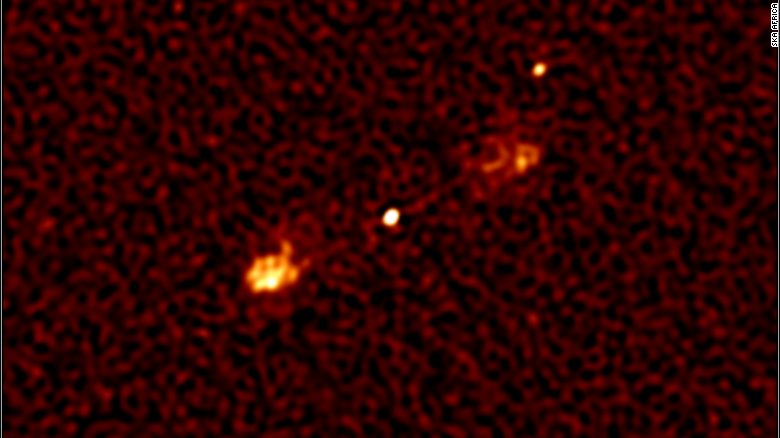
A "Fanaroff-Riley Class 2" (FR2) object: a massive black hole in the distant universe (matter falling into it produces
the bright dot at the center) launching jets of powerful electrons moving at close to the speed of light.
----------------------
It will be incredible when SKA comes online! Can you imagine, 10,000 times more "capable" than current instruments!! - IlanLast edited by ilan; 07-18-2016 at 02:05 PM.
Beginner's Guide for Rocket, NFPS and IKS66...
http://iptvtalk.net/showthread.php?2...-you-should-do
Kodi Options for Rocket, NFPS and IKS66...
http://iptvtalk.net/forumdisplay.php?71-Kodi
Check the Announcement Section...
http://iptvtalk.net/forumdisplay.php...-Announcements
-
07-19-2016, 04:07 PM #313Huge UFO over NY baffles witnesses, what do you think it is? (VIDEO)
RT Question More | Published time: 18 Jul, 2016 18:40 Edited time: 19 Jul, 2016 08:16

A video shot by confused motorists who spotted a massive UFO has been shared online.
The clip, captured on Sunday, shows a large black object hovering above the New York City skyline. It was visible to drivers making the Outerbridge Crossing to New Jersey.
The footage was shared by “UFO investigators” Secure Team 10, who claim “to bring exposure to the alien phenomenon.” They said multiple eyewitnesses submitted clips and reported feeling strange “vibrations,” as well as hearing “unnatural” sounds in the area.Code:www.gifs.com/gif/yP458R
Secure Team’s Tyler Glockner claimed that this most recent sighting was just the latest of many, which some believe may indicate that “we are on the precipice of a visitation.”
The video has been viewed on YouTube more than 200,000 times since its upload on Saturday and has prompted the usual debate.
Some commenters questioned how a massive UFO could go undetected by the residents directly beneath it, or at least closer to the object.
“Isn’t it strange that EVERY single UFO video is of a UFO far away? rarely a video off someone who is underneath it or very close?,” wrote one commenter.
“Interesting video Tyler but one or two persons couldn’t have been the only ones who snapped this thing on video especially over a big city like New Jersey but still very strange indeed!” wrote Mike Carr.
Others dismissed the ominous object as a “whole lotta nothing” or simply “the government experimenting with a new drone.”Code:https://youtu.be/oX6vWdHcGUM
Beginner's Guide for Rocket, NFPS and IKS66...
http://iptvtalk.net/showthread.php?2...-you-should-do
Kodi Options for Rocket, NFPS and IKS66...
http://iptvtalk.net/forumdisplay.php?71-Kodi
Check the Announcement Section...
http://iptvtalk.net/forumdisplay.php...-Announcements
-
07-20-2016, 11:07 AM #314GOVERNMENT CHIEF'S DEATH BED CONFESSION: 'I was shown inside alien UFO at Area 51'
By Jon Austin, Express | PUBLISHED: 13:04, Sun, Jul 17, 2016 | UPDATED: 13:29, Sun, Jul 17, 2016
A FORMER government emergency expert made a detailed death bed confession of how he was shown inside an alien flying saucer at the top-secret Area 51 military base, it has been sensationally claimed.

Paul Hellyer and the no-entry signs at Area 51.
Paul Hellyer, a former Canadian Minister of Defencem, said an unnamed former Canadian Chief of Emergency Measures revealed the astonishing story just before his death from a neurological illness.
Mr Hellyer, 92, revealed the claim to a panel of the world's top UFO and alien investigators and experts.
Speaking at the "Hearing on ET Disclosure” in Brantford, Ontario, Canada, Mr Hellyer explained that if he wanted to know about the workings of an alien space craft he would "ask the current chief of emergency measures".
Mr Hellyer, who became a UFO expert after claiming to have seen proof of alien visitations while in office, said: "The reason I know is I interviewed the previous one, who is now deceased, and he went Langley and the CIA asked if he would like to see one of these crafts.
"They flew him to Area 51 and let him go inside one and observe it and make notes and this sort of thing."
Conspiracy theorists have insisted for years Area 51 is where evidence of alien visitations of Earth are secretly held away from public view, including the remains of the alleged 1947 Roswell flying saucer crash.
The top-secret military base in the Nevada desert, America, has intrigued and mystified UFO and alien chasers for years, particularly as the US Government only and reluctantly confirmed its existence in 2013.
Mr Hellyer added: "I guess, presumably, it was to be in better to cops with it if one crashed here and he was involved in trying to do something positive about it.
"But before he was allowed to go had to go he had to sign an oath of secrecy and not tell anyone, and during his life he didn't tell anyone including his wife, and an Air Force buddy phoned me and he was dying of Lou Gehrig’s disease and at that point he felt he should tell someone.

Paul Hellyer said the dying official confirmed he was shown inside alien technology at Area 51.
"I phoned him and he gave me a full report of what he saw and the whole idea of the inside of the craft and this sort of thing, and the fact he had been in a brief and many things, but now he felt he could tell somebody and he thought that would be a good one to tell."
Mr Hellyer was Canadian Minister of Defence from 1963 to 1968 and was deputy prime minister in 1969, but outed himself as a UFO believer 11 years ago.
Last year he made headlines across the globe after claiming up to 80 different species of aliens were in communication with world leaders, but governments across the world were involved in a mass cover up.
He told a TV news interview that some of the aliens lived on one of Saturn's moons called Andromedia.
But sceptics claim he was deluded and to have debunked him because none of Saturn's 62 moons and satellites have this name.
Victor Viggiani, who chaired the hearing, said: "The more important and dramatic piece of evidence presented by Hellyer was a story he told about the day he was called to listen to some death bed confession.
"Paul did not provide dates for the events but he received a call from a man who said that the former head of emergency measures in Canada and that he has a story he wanted to get off his chest."Beginner's Guide for Rocket, NFPS and IKS66...
http://iptvtalk.net/showthread.php?2...-you-should-do
Kodi Options for Rocket, NFPS and IKS66...
http://iptvtalk.net/forumdisplay.php?71-Kodi
Check the Announcement Section...
http://iptvtalk.net/forumdisplay.php...-Announcements
-
07-21-2016, 03:48 AM #315
the truth is out now where are they i can take the truth
-
07-21-2016, 12:03 PM #316
Yep, it would be nice to know once and for all. If they do exist, it's hard to fathom why they'd hide that fact, at least for this many years. That, too, is a potential mystery.
Last edited by ilan; 07-21-2016 at 12:21 PM.
Beginner's Guide for Rocket, NFPS and IKS66...
http://iptvtalk.net/showthread.php?2...-you-should-do
Kodi Options for Rocket, NFPS and IKS66...
http://iptvtalk.net/forumdisplay.php?71-Kodi
Check the Announcement Section...
http://iptvtalk.net/forumdisplay.php...-Announcements
-
07-21-2016, 12:05 PM #317X marks the spot at the centre of the Milky WayTwo astronomers — with the help of social media — have uncovered the strongest evidence yet that an enormous X-shaped structure made of stars lies within the central bulge of the Milky Way Galaxy.
University of Toronto Press Release via Astronomy Now | 20 July 2016
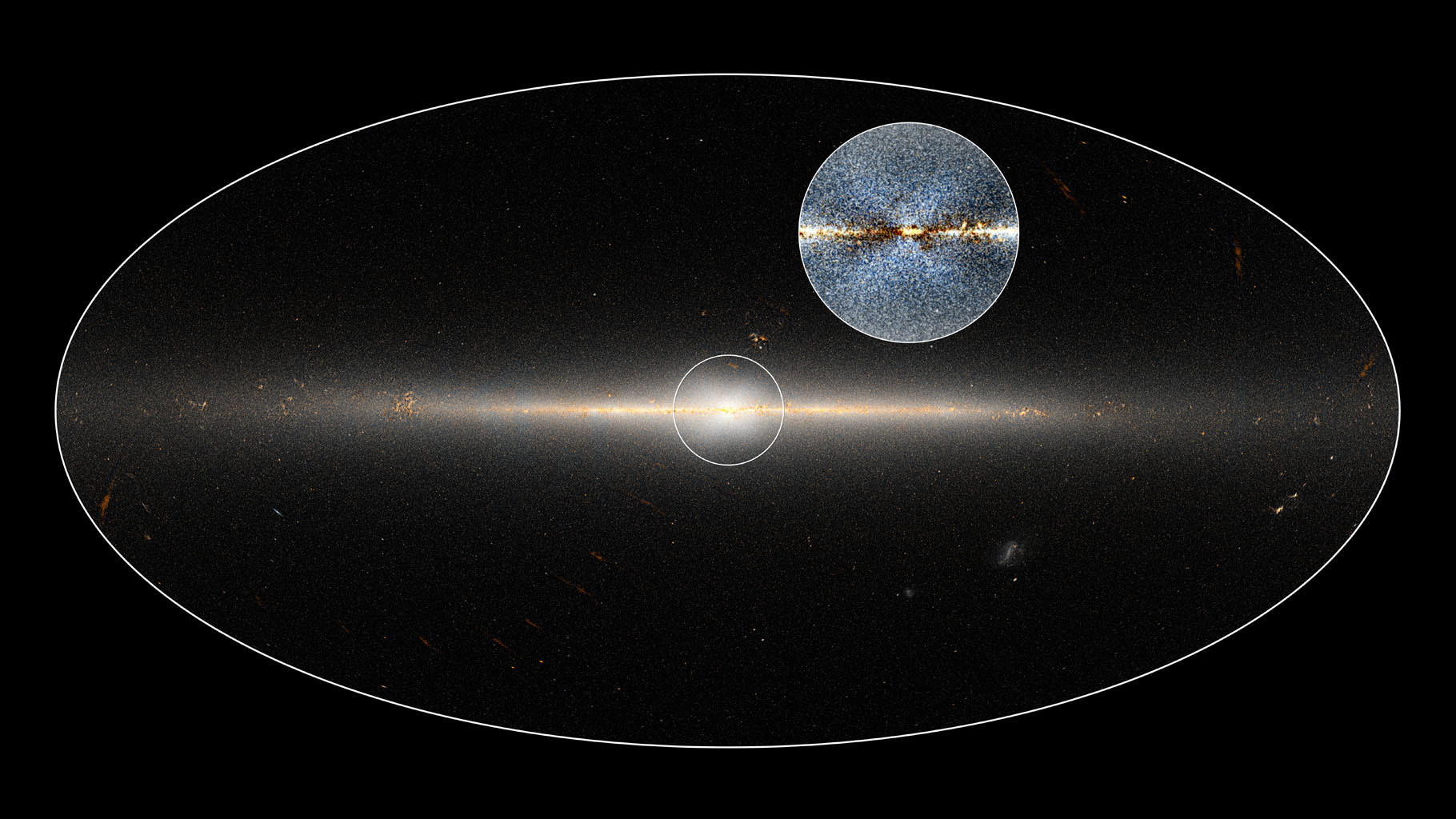
WISE all-sky image of Milky Way Galaxy. The circle is centred on the Galaxy’s central region. The inset shows an enhanced version of the same region that shows a clearer view of the X-shaped structure. Illustration credit: NASA/JPL-Caltech; D. Lang/Dunlap Institute.
Previous computer models, observations of other galaxies, and observations of our own galaxy have suggested that the X-shaped structure existed. But no one had observed it directly; and some astronomers argued that previous research that pointed indirectly to the existence of the X could be explained in other ways.
“There was controversy about whether the X-shaped structure existed,” says Dustin Lang, a Research Associate at the Dunlap Institute for Astronomy & Astrophysics, University of Toronto, and co-author of the paper describing the discovery. “But our paper gives a good view of the core of our own galaxy. I think it has provided pretty good evidence for the existence of the X-shaped structure.”
The results appear in the July issue of the Astronomical Journal. The lead author is Melissa Ness, a postdoctoral researcher at the Max Planck Institute for Astronomy in Heidelberg.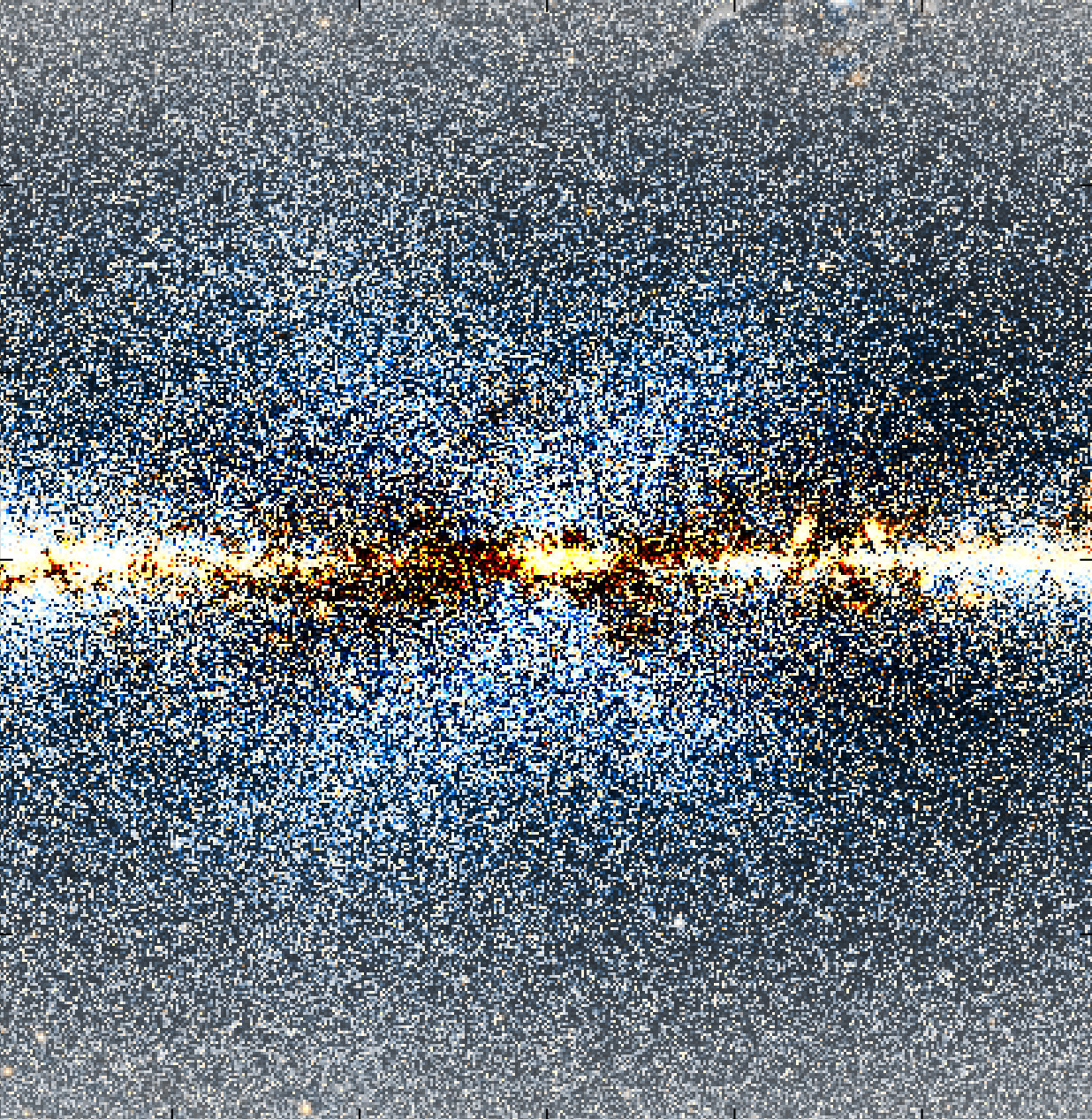 An enhanced, close-up view centred on the Milky Way Galaxy’s bulge and the blue-tinted “X.” Image credit: D. Lang/Dunlap Institute.
An enhanced, close-up view centred on the Milky Way Galaxy’s bulge and the blue-tinted “X.” Image credit: D. Lang/Dunlap Institute.
The Milky Way Galaxy is a barred spiral galaxy: a disc-shaped collection of dust, gas and billions of stars, 100,000 light-years in diameter. It is far from a simple disc structure, being comprised of two spiral arms, a bar-shaped feature that runs through its centre, and a central bulge of stars. The central bulge, like other barred galaxy’s bulges, resembles a rectangular box or peanut when viewed — as we view it — from within the plane of the galaxy. The X-shaped structure is an integral component of the bulge.
Astronomers think the bulge could have formed in two different ways: it may have formed when the Milky Way Galaxy merged with other galaxies; or it may have formed without the help of external influences as an outgrowth of the bar, which itself forms from the evolving galactic disc. Lang and Ness’s finding supports the latter model which predicts the box- or peanut-shaped bulge and the galactic X.
This latest, clearest view of the bulge emerged when Lang re-analysed previously released data from the Wide-field Infrared Survey Explorer (WISE), a space telescope launched by NASA in 2009. Before ending its initial mission in 2011, WISE surveyed the entire sky in infrared — imaging three-quarters of a billion galaxies, stars and asteroids.
“The bulge is a key signature of formation of the Milky Way Galaxy,” says Ness. “If we understand the bulge we will understand the key processes that have formed and shaped our galaxy.”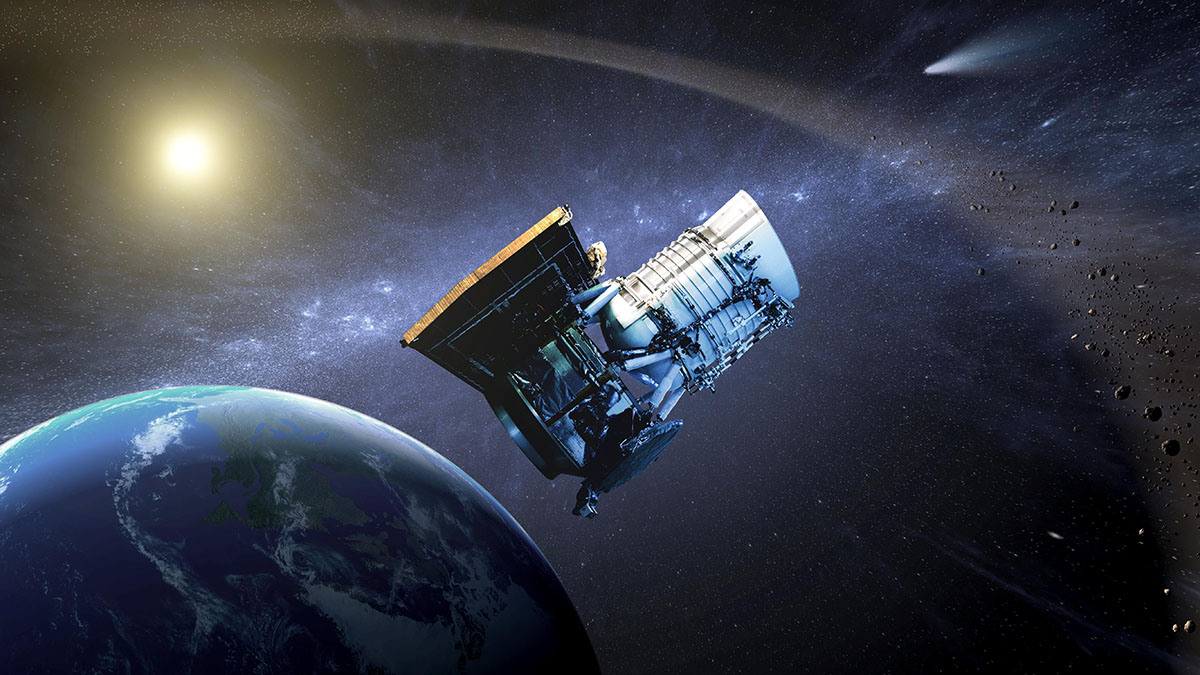
The Wide-field Infrared Survey Explorer (WISE) spacecraft. Illustration credit: NASA/JPL-Caltech.
“The shape of the bulge tells us about how it has formed. We see the X-shape and boxy morphology so clearly in the WISE image and this demonstrates that internal formation processes have been the ones driving the bulge formation.”
It is also evidence that our galaxy did not experience major merging events since the bulge formed. If it had, interactions with other galaxies would have disrupted its shape.
Lang’s analysis was originally intended to aid in his research in mapping the web of galaxies beyond the Milky Way Galaxy. To help explore the maps he’d developed from the WISE data, he created an interactive map-browsing website and tweeted an image of the entire sky.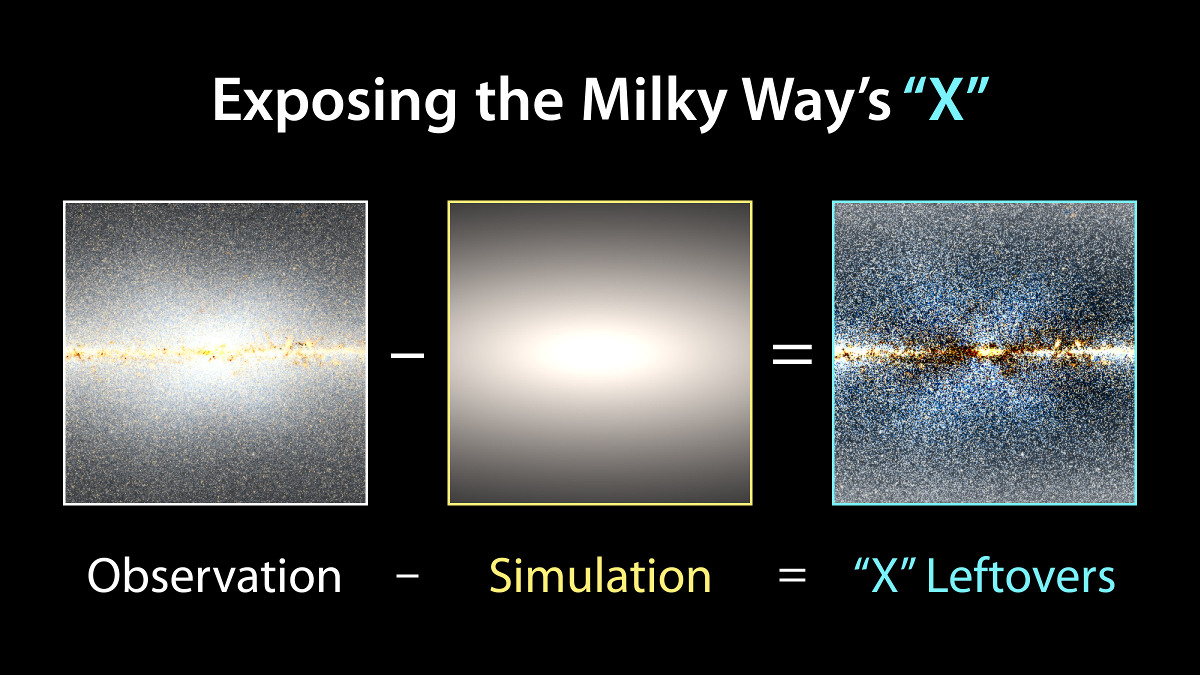
To reveal the X shape in the Milky Way’s central bulge, researchers took WISE observations and subtracted a model of how stars would be distributed in a symmetrical bulge. Illustration credit: NASA/JPL-Caltech/D. Lang.
“Ness saw the tweet and immediately recognised the importance of the X-shaped structure,” says Lang. “We arranged to meet at an upcoming conference we were both attending. The paper was born from that meeting. That’s the power of large surveys and open science!”Last edited by ilan; 07-21-2016 at 12:13 PM.
Beginner's Guide for Rocket, NFPS and IKS66...
http://iptvtalk.net/showthread.php?2...-you-should-do
Kodi Options for Rocket, NFPS and IKS66...
http://iptvtalk.net/forumdisplay.php?71-Kodi
Check the Announcement Section...
http://iptvtalk.net/forumdisplay.php...-Announcements
-
07-22-2016, 12:37 PM #318What Would Happen If Comet Swift-Tuttle Hit the Earth?
By Greg Uyeno, Staff Writer Live Science | July 21, 2016 11:30am ET

The Perseid meteor shower. Credit: SKY2015 | Shutterstock.com
Shooting stars may fill you with child-like wonder, but these celestial showstoppers are also reminders that Earth is hardly alone in space, and some of those cosmic objects can be downright dangerous.
The Perseid meteor shower, which appears every year in mid-August, occurs when Earth passes through a trail of debris left by Comet Swift-Tuttle. In 1973, based on calculations about the object's orbit using limited observations, astronomer Brian Marsden at the Harvard-Smithsonian Center for Astrophysics predicted that Comet Swift-Tuttle could collide with Earth in 2126. The catastrophic prediction was later retracted, but what would happen if Comet Swift-Tuttle smacked into our planet?
"We have to be clear that it's not going to happen," Donald Yeomans, a senior research scientist at NASA's Jet Propulsion Laboratory in Pasadena, California, and author of "Near-Earth Objects: Finding Them Before They Find Us" (Princeton University Press, 2012), told Live Science. [Perseid Meteor Shower 2016: When, Where & How to See It]
When Swift-Tuttle was last seen in 1992, Yeomans was among those who produced revised models for the comet's motion, making the complicated calculations to account for the gravitational effects of the sun and planets on the space rock's orbit. The 1992 sighting, along with data from 1862 and 1737, provided astronomers with enough information to rule out the possibility of a collision in 2126.
Even still, Comet Swift-Tuttle isn't just another space rock.
Comet Swift-Tuttle is "certainly one of the largest" objects that crosses paths with the Earth, Yeomans said. The cosmic object measures about 16 miles (26 kilometers) across, and when it passes close to the Earth, roughly every 130 years, it's hurtling through space at about 36 miles per second (58 km/s), or more than 150 times the speed of sound.
If the comet were to strike the planet, the impact energy would be about 300 times that of the asteroid collision that was thought to have caused the Cretaceous-Tertiary extinction that killed the dinosaurs about 65 million years ago, according to Yeomans. "It would be a very bad day for Earth," he said.
But the size of a comet or asteroid isn't the only thing to consider with cosmic collisions, said Gerta Keller, a geoscientist at Princeton University.
A comet strike on land or in shallow seas would be "rather destructive" regionally, but the real damage would likely come from gases put into the stratosphere, the part of Earth's atmosphere where the ozone layer is located, Keller told Live Science. Sulfur dioxide would initially cause cooling, and then carbon dioxide would lead to long-term warming, she added. An event like this would likely cause the planet's climate to change drastically, leading to mass extinctions around the globe. [Crash! 10 Biggest Impact Craters on Earth]
But Keller also pointed out that most of Earth's surface is covered in ocean. An impact in the deep ocean could trigger earthquakes and tsunamis, but based on what scientists know about the effects of underwater volcanic eruptions, the atmospheric effects likely would be mitigated by the ocean, she said. In this case, Keller said it's unlikely that a comet colliding with Earth would cause mass extinctions.
Scientists calculate that Swift-Tuttle's next approach to Earth will be on Aug. 5, 2126, when it will come within about 14 million miles, or 23 million km, or about 60 times the distance from Earth to the moon, Yeomans said. Current models don't expect the comet to ever get any closer than about 80,000 miles (130,000 km) to Earth's orbit, but as time passes, those predictions become less and less certain. So although Yeomans is sure that Earth faces no threat in 2126, he said 10,000 years from now, "you can't rule out the possibility, but it would seem to be very unlikely."
Part of that slim uncertainty is due to small influences on the comet that change its orbit ever so slightly each time it swings around the sun. For example, as comets pass near the sun and heat up, expanding gases act like jet thrusters, slightly altering the trajectory. For Swift-Tuttle, that effect is very small, likely due to the comet's tremendous mass, Yeomans said. But over thousands of years, these minute, unpredictable effects make it more difficult to predict the orbit of cosmic objects.
And there are plenty of other objects out there to be aware of, Yeomans said. "We have a long, long list of asteroids for which we haven't completely ruled out a collision, but the impact probabilities are so small that it's not really worth worrying about," he said.Last edited by ilan; 07-22-2016 at 12:40 PM.
Beginner's Guide for Rocket, NFPS and IKS66...
http://iptvtalk.net/showthread.php?2...-you-should-do
Kodi Options for Rocket, NFPS and IKS66...
http://iptvtalk.net/forumdisplay.php?71-Kodi
Check the Announcement Section...
http://iptvtalk.net/forumdisplay.php...-Announcements
-
07-23-2016, 12:15 PM #319Seeing a Black Hole’s Gravitational Vortex
By: Monica Young, Sky & Telescope | July 19, 2016
New observations solve a 30-year-old puzzle of mysterious signals from around black holes.
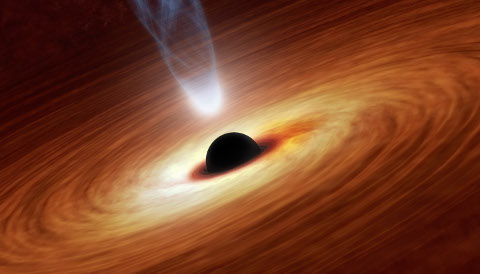
An artist's conception of a supermassive black hole. NASA/JPL-Caltech
Strange things happen around black holes, especially spinning ones. Their strong gravitational pull means they don’t just pull in gas to munch on — they drag the very fabric of spacetime around them as they spin.
Every rotating massive body does this — even puny Earth, as measured by the Gravity Probe B. But around black holes the so-called frame-dragging effect (also known as the Lense-Thirring effect) is particularly strong. Like flies stuck in honey, anything embedded in that spacetime will get dragged along, too. And now, with new observations from the XMM-Newton and NuSTAR space telescopes, astronomers have connected the effect to long-mysterious signals seen around stellar-mass black holes.
Black Hole Beats
While we can’t see black holes directly, we can see those that are guzzling gas. Such meals are easy to come by for black holes in binary systems, as they pull mass from their unlucky companion stars. As the gas spirals inward, it heats up: the closer it comes to the black hole, the hotter the gas will be, and the higher the frequency of the photons it radiates. Very near the black hole, the plasma reaches a fevered pitch, puffing up and emitting energetic X-rays.
 This artist's impression depicts an accretion disk surrounding a black hole. The black hole drags spacetime with it as it spins. So X-ray-emitting plasma near the black hole, stuck in spacetime like a fly stuck in honey, precesses. The X-rays strike matter in the surrounding disk, making it to glow like a fluorescent bulb. The glow appears to rotate around the accretion disc to the right (top), to the front (middle), and to the left (bottom).
This artist's impression depicts an accretion disk surrounding a black hole. The black hole drags spacetime with it as it spins. So X-ray-emitting plasma near the black hole, stuck in spacetime like a fly stuck in honey, precesses. The X-rays strike matter in the surrounding disk, making it to glow like a fluorescent bulb. The glow appears to rotate around the accretion disc to the right (top), to the front (middle), and to the left (bottom).
ESA / ATG medialab
Back in the 1980s, astronomers started seeing signals amidst these flickering X-rays that looked suspiciously regular. Dubbed quasi-periodic oscillations, these QPOs seemed to come from something whizzing intriguingly close-in around the black hole. More than a decade later, an idea emerged: astronomers could be witnessing the frame dragging effect in action.
Here’s the general picture: hot puffed-up plasma very near the black hole radiates X-rays. Some of these X-rays hit the surrounding gas disk, knocking electrons off of iron atoms in the swirling gas. As those iron atoms snatch back their electrons, they fluoresce, emitting X-rays at a specific energy.
The whole system — the black hole, the hot inner plasma, and the surrounding disk — is spinning like a top. And if the disk is tilted relative to the black hole, then the top will wobble, or precess. We’ll see the hot plasma fluoresce off of part of the outer disk, and that fluorescence will appear to rotate around the black hole. When we’re seeing a part of the disk spinning around toward Earth, we’ll see its iron emission blueshifted; emission from a part of the disk spinning away again will shift redward.
Adam Ingram (University of Amsterdam, The Netherlands) and colleagues set out to observe this effect directly. They pointed the XMM-Newton and NuSTAR space telescopes at the system known as H1743-322, where a black hole with a mass of about 10 Suns is drawing in gas from its companion star. Four of the five observations clearly show the iron line shifting back and forth in the spectrum over the course of 4 to 5 seconds, exactly in the way that the frame-dragging effect predicts.
“This is a very intriguing result,” says Laura Brenneman (Harvard-Smithsonian Center for Astrophysics), who was not involved with the study. “Certain types of QPOs in X-ray[-emitting black hole] binaries have long been suspected to arise from some form of precession, but this result is the closest thing I've seen to hard evidence for that.”
This result turns stellar-mass black holes into a proving ground for new physics. “If you can get to the bottom of the astrophysics, then you can really test general relativity,” Ingram said in NASA’s press release, welcome news to physicists who are searching for a deeper theory of gravity.
One of These Is Not Like the Others
Over 3 days’ worth of exposure, XMM-Newton collected five sets of data. While four of these matched beautifully, one, known as orbit 1b, didn’t conform at all to expectations. It could simply be that some gas obstructed the astronomers’ view, or it could be that the observation is telling astronomers something more fundamental.
“I am curious as to what is going on in XMM-Newton’s orbit 1b that is so anomalous compared to the others,” Brenneman adds, “but I don't think it diminishes the result at all, just adds an extra dimension and opens up more questions.”
Another intriguing aspect of QPOs is that they’ve (almost) never been seen in the supermassive variety of black holes. These active galactic nuclei (AGN) guzzle gas at the center of galaxies with the same setup as stellar-mass black holes: a black hole, a gas disk, and X-ray-emitting plasma. The only thing they’re missing is the binary companion star.
“There has only been one reputable claim of a QPO in an AGN back in 2008, and it hasn't been seen again since,” Brenneman says. “If there were QPOs-a-plenty in AGN, we would likely have detected them by now.” Why they aren’t there, no one knows.
With one mystery solved, it’s clear there are still more cases awaiting closure.Beginner's Guide for Rocket, NFPS and IKS66...
http://iptvtalk.net/showthread.php?2...-you-should-do
Kodi Options for Rocket, NFPS and IKS66...
http://iptvtalk.net/forumdisplay.php?71-Kodi
Check the Announcement Section...
http://iptvtalk.net/forumdisplay.php...-Announcements
-
07-25-2016, 01:15 PM #320This short documentary shows how astronomers hope to find the next habitable planets
By Andrew Liptak, The Verge | July 24, 2016 04:22 pm
Trying to discover habitable planets isn't just for science fiction anymore
Just a couple of decades ago, the very idea that there were other planets orbiting stars throughout the universe was something that belonged to science fiction. However, recent research has shown not only are there other planets out there, but they’re extremely common. The short documentary The Search for Earth Proxima outlines the breakthroughs that have led us to these discoveries, and how a group of astronomers plan to look for habitable planets in our neighborhood.
Equipment such as the Kepler spacecraft has helped us find planets that are not only orbiting stars, but that there are planets out there that are the right size and at the right distance away from their host star to potentially harbor Earth-like conditions.
It’s hard to detect these Earth-like planets: they’re extremely faint — one astronomer likened it to trying to spot a firefly in a spotlight from 10 miles away. Fortunately, nearby stars make this task a bit easier, and the astronomers want to take a closer look at Alpha Centauri A and B, our closest stellar neighbors.
The group is hoping that technological advances will help them move beyond Kepler and on to other programs that will help them directly study Alpha Centauri.Code:https://vimeo.com/channels/staffpicks/174313049
One idea that they float is Program Centaur, a small space telescope designed to locate any Earth-like planets discovered around the binary star system. The spacecraft is the size of a washing machine, and they pointed to the rise of commercial space providers such as SpaceX as a potential partner to get their equipment into orbit.
With the huge number of planets out there, it feels as though it's just a matter of time before an Earth-like (and potentially habitable) world is discovered. Maybe, that day isn't too far off.Beginner's Guide for Rocket, NFPS and IKS66...
http://iptvtalk.net/showthread.php?2...-you-should-do
Kodi Options for Rocket, NFPS and IKS66...
http://iptvtalk.net/forumdisplay.php?71-Kodi
Check the Announcement Section...
http://iptvtalk.net/forumdisplay.php...-Announcements
Similar Threads
-
RCU model pics
By crazed 9.6 in forum BuzzTV RemotesReplies: 25Last Post: 01-05-2024, 10:41 PM -
BuzzTV e1 - pics
By Ryu in forum BuzzTV EssentialsReplies: 0Last Post: 02-01-2021, 01:06 AM -
Zx Pics
By Capt.Kangaroo in forum Formuler ZxReplies: 17Last Post: 09-21-2018, 02:38 PM -
This is cool pics
By Marley in forum Chit Chat LoungeReplies: 0Last Post: 03-06-2018, 06:41 PM -
Space Pics v.3
By Capt.Kangaroo in forum Deep SpaceReplies: 527Last Post: 05-25-2016, 02:09 PM








 Reply With Quote
Reply With Quote


